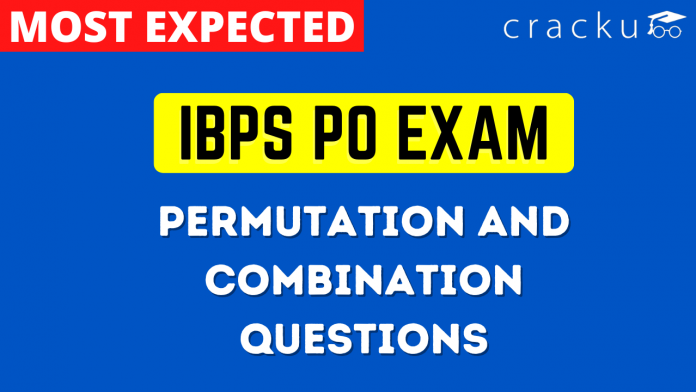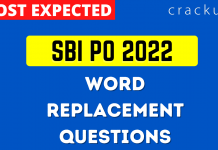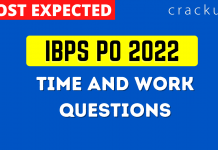Permutation and Combination Questions for IBPS PO Prelims
Permutation and Combination is one of the key topics in the IBPS PO Prelims exam. Here you can download free Permutation and Combination questions PDF with answers for IBPS PO Prelims 2022 by Cracku. These questions will help you to practice and solve the Permutation and Combination questions in the IBPS PO exams. Utilize this best PDF practice set which includes the answers in detail. Click on the below link to download the Permutation and Combination Usage MCQ questions PDF for IBPS PO Prelims 2022 for Free.
Download Permutation and Combination Questions for IBPS PO Prelims
Download IBPS PO Previous Papers
Question 1: Letters of the word DIRECTOR are arranged in such a way that all the vowel come together .Find the No of ways making such arrangement?
a) 4320
b) 720
c) 2160
d) 120
e) None of these
1) Answer (A)
Solution:
Word – DIRECTOR
So “I,E,O” are there are 3! ways to arrange the vowels
Now “D,R,C,T,R” are the remaining alphabets ,
Condition is that the vowels should always be together so we can assume the vowels as a single alphabet/unit say “X” (‘X’=’I,E,O’) so now we have a new word – “D,R,C,T,R,X”
Possible arrangements for this word = 6!
Thus total number of ways to rearrange DIRECTOR with vowels grouped together = (Possible arrangements of ‘DRCTRX’) $\times$ (Possible arrangements of vowels)
= 6! $\times$ 3! = $720 \times 6 = 4320$
=> Ans – (A)
Question 2: In a box carrying one dozen of oranges one third have become bad.If 3 oranges taken out from the box random ,what is the probability that at least one orange out of the 3 oranges picked up is good ?
a) 1/55
b) 54/55
c) 45/55
d) 3/55
e) None of these
2) Answer (B)
Solution:
Total number of oranges in the box = 12
Number of ways of selecting 3 oranges out of 12 oranges, n(S) = $C^{12}_3$
= $\frac{12 \times 11 \times 10}{1 \times 2 \times 3} = 220$
Number of oranges which became bad = $\frac{12}{3}=4$
Number of ways of selecting 3 oranges out of 4 bad oranges = $C^4_3 = C^4_1 = 4$
Number of desired selection of oranges, n(E) = 220 – 4 = 216
$\therefore$ $P(E) = \frac{n(E)}{n(S)}$
= $\frac{216}{220}= \frac{54}{55}$
=> Ans – (B)
Instructions
Study the information carefully to answer the following questions:
A bucket contains 8 red, 3 blue and 5 green marbles.
Question 3: If 3 marbles are drawn at random, what is the probability that none is red ?
a) ${3 \over 8}$
b) ${1 \over {16}}$
c) ${1 \over {10}}$
d) ${3 \over {16}}$
e) None of these
3) Answer (C)
Solution:
Number of ways of drawing 3 marbles out of 16
$n(S) = C^{16}_3 = \frac{16 \times 15 \times 14}{1 \times 2 \times 3}$
= $560$
Out of the three drawn marbles, none is red, i.e., they will be either blue or green.
=> $n(E) = C^8_3 = \frac{8 \times 7 \times 6}{1 \times 2 \times 3}$
= $56$
$\therefore$ Required probability = $\frac{n(E)}{n(S)}$
= $\frac{56}{560} = \frac{1}{10}$
Question 4: If 2 marbles are drawn at random, what is the probability that both are green?
a) ${1 \over 8}$
b) ${5 \over {16}}$
c) ${2 \over 7}$
d) ${3 \over 8}$
e) None of these
4) Answer (E)
Solution:
Number of ways of drawing 2 marbles out of 16
$n(S) = C^{16}_2 = \frac{16 \times 15}{1 \times 2}$
= $120$
Out of the two drawn marbles, both are green
=> $n(E) = C^5_2 = \frac{5 \times 4}{1 \times 2}$
= $10$
$\therefore$ Required probability = $\frac{n(E)}{n(S)}$
= $\frac{10}{120} = \frac{1}{12}$
Question 5: If 4 marbles are drawn at random, what is the probability that 2 are red and 2 are blue ?
a) ${{11} \over {16}}$
b) ${3 \over {16}}$
c) ${11 \over {72}}$
d) ${3 \over {65}}$
e) None of these
5) Answer (D)
Solution:
Number of ways of drawing 4 marbles out of 16
=> $n(S) = C^{16}_4 = \frac{16 \times 15 \times 14 \times 13}{1 \times 2 \times 3 \times 4}$
= $1820$
Out of the four drawn marbles, 2 are red and 2 are blue.
=> $n(E) = C^8_2 \times C^3_2 = \frac{8 \times 7}{1 \times 2} \times \frac{3 \times 2}{1 \times 2}$
= $28 \times 3 = 84$
$\therefore$ Required probability = $\frac{n(E)}{n(S)}$
= $\frac{84}{1820} = \frac{3}{65}$
Instructions
From the following, differen committees are to be made as per the requirement given in each question.
In how many different ways can it de done? 10 men and 8 women out of which 5 men are teachers, 3 men doctors and businessmen. Among the women, 3 are 2 are teachers, 2 doctors, 2 researchers and 1 social worker.
Question 6: A Committee of 3 in which there is no teacher and no doctor.
a) 100
b) 120
c) 10
d) 12
e) None of these
6) Answer (C)
Solution:
Out of 10 men, Teachers = 5
Doctors = 3 and Business man = 2
Out of 8 women, Teachers = 3 and Doctors = 2
Researchers = 2 and Social worker = 1
Now, no teacher and doctor should be selected.
=> Remaining members (both men and women) = (2) + (2 + 1) = 5
Thus, number of ways of selecting 3 people out of 5
= $C^5_3 = \frac{5 \times 4 \times 3}{1 \times 2 \times 3} = 10$
Question 7: A Committee of 7.
a) 31824
b) 1200
c) 9600
d) 15912
e) None of these
7) Answer (A)
Solution:
There are 10 men and 8 women, Total = 18
Number of ways of selecting 7 members out of 18.
= $C^{18}_7 = \frac{18 \times 17 \times 16 \times 15 \times 14 \times 13 \times 12}{1 \times 2 \times 3 \times 4 \times 5 \times 6 \times 7}$
= $18 \times 17 \times 4 \times 13 \times 2 = 31824$
Question 8: A Committee is 5 in which 2 men teachers, 2 women teachers and 1 doctor are there.
a) 75
b) 150
c) 214
d) 20
e) None of these
8) Answer (B)
Solution:
Out of 10 men, Teachers = 5
Doctors = 3 and Business man = 2
Out of 8 women, Teachers = 3 and Doctors = 2
Researchers = 2 and Social worker = 1
Number of ways of selecting 2 men teachers, 2 women teachers and 1 doctor
= $C^5_2 \times C^3_2 \times C^5_1$
= $\frac{5 \times 4}{1 \times 2} \times \frac{3 \times 2}{1 \times 2} \times \frac{5}{1}$
= $10 \times 3 \times 5 = 150$
Question 9: A Committee of 5 in which 3 men and 2 women are there.
a) 3360
b) 8568
c) 4284
d) 1680
e) None of these
9) Answer (A)
Solution:
Out of 10 men, Teachers = 5
Doctors = 3 and Business man = 2
Out of 8 women, Teachers = 3 and Doctors = 2
Researchers = 2 and Social worker = 1
Number of ways of selecting 3 men and 2 women.
= $C^{10}_3 \times C^8_2$
= $\frac{10 \times 9 \times 8}{1 \times 2 \times 3} \times \frac{8 \times 7}{1 \times 2}$
= $120 \times 28 = 3360$
Question 10: In how many different ways can the letters of the word TRUST’ be arranged?
a) 240
b) 120
c) 80
d) 25
e) None of these
10) Answer (E)
Solution:
Word = ‘TRUST’
There are 5 letters and ‘T’ is repeated.
If there are ‘n’ letters and ‘r’ are repeating, then number of ways of arranging them = $\frac{n !}{r !}$
$\therefore$ Number of ways in which letters of the word ‘TRUST’ can be arranged
= $\frac{5 !}{2 !} = \frac{5 \times 4 \times 3 \times 2 \times 1}{2 \times 1}$
= $5 \times 4 \times 3 = 60$
=> Ans – (E)
Question 11: How many such pairs of letters are there in the word FOREHAND each of which have as many letters between them in the word as they have in the English alphabet?
a) None
b) One
c) Two
d) Three
e) More than three
11) Answer (C)
Solution:
Word = FOREHAND
There are 2 pairs of letters which have as many letters between them in the word as they have in the English alphabet
FA and RN
Question 12: If it is possible to make only one meaningful word from the second, the fourth, the sixth and the ninth letters of the word PROACTIVE, using each letter only once, second letter of that word is your answer. If more than one word can be formed your answer is M and if no such word can be formed your answer is N.
a) A
b) E
c) T
d) M
e) N
12) Answer (D)
Solution:
Word = PROACTIVE
2nd, 4th, 6th and 9th letters = R, A, T, E
No. of words that can be formed by using (R,A,T,E)
= Rate , Tear
Since only 2 words are formed
=> Ans = M
Question 13: In how many different ways can the letters of the word DRASTIC be arranged in such a way that the vowels always come together ?
a) 720
b) 360
c) 1440
d) 540
e) None of these
13) Answer (C)
Solution:
There are 7 letters in the word ‘DRASTIC’ including 2 vowels (A,I) and 5 consonants (D,R,S,T,C).
Considering the two vowels as 1 letter, we have 6 letters which can be arranged in 6! ways
But corresponding to each way of these arrangements, the vowels can be put together in 2! ways.
Hence, required number of words = $6! \times 2!$
= 720 * 2 = 1440
Question 14: Which of the following set of fractions is in ascending order ?
a) 13/15, 11/13, 7/8, 8/9
b) 11/13, 13/15, 7/8, 8/9
c) 8/9, 7/8, 13/15, 11/13
d) 7/8, 8/9, 11/13, 13/15
e) None of these
14) Answer (B)
Solution:
Decimal equivalent of :
$\frac{13}{15} = 0.87$
$\frac{11}{13} = 0.85$
$\frac{7}{8} = 0.875$
$\frac{8}{9} = 0.89$
Clearly, 0.85 < 0.87 < 0.875 < 0.89
=> $\frac{11}{13} < \frac{13}{15} < \frac{7}{8} < \frac{8}{9}$
Question 15: Certain number of pieces of an article are to be packed in boxes, such that each box contains 145 pieces. If after packing them in 32 boxes 25 pieces are left out, what was the number of pieces to be packed ?
a) 4566
b) 4655
c) 4465
d) 4640
e) None of these
15) Answer (E)
Solution:
No. of pieces
= 32 * 145 + 25
= 4640 + 25 = 4665
Question 16: In how many different ways can the letters of the word ‘HAPPY’ be arranged ?
a) 120
b) 140
c) 60
d) 70
e) None of these
16) Answer (C)
Solution:
The word HAPPY contains 5 letters in which letter ‘P’ comes twice.
=> Number of arrangements = $\frac{5!}{2!}$
= $\frac{120}{2} = 60$
Question 17: In how many different ways can the letters of the word ‘FRANCE’ be arranged ?
a) 2400
b) 720
c) 2005
d) 5040
e) None of these
17) Answer (B)
Solution:
The word FRANCE consists of 6 distinct letters
=> Required number of arrangements = 6!
= 720
Question 18: In how many different ways can the letters of the word ‘CREAM’ be arranged?
a) 720
b) 240
c) 360
d) 504
e) None of these
18) Answer (E)
Solution:
The word CREAM consists of five distinct letters
=> No. of ways the letters will be arranged = $5!$
= 120
Question 19: In how many different ways can the letters of the word “ARISE’ be arranged?
a) 90
b) 60
c) 180
d) 120
e) None of these
19) Answer (D)
Solution:
The word ‘ARISE’ has 5 different letters
=> Required number of arrangements = $5!$
= $5 \times 4 \times 3 \times 2 \times 1 = 120$
Question 20: In how many different ways can the letters of the world ‘SECOND’ be arranged?
a) 720
b) 120
c) 5040
d) 270
e) None of these
20) Answer (A)
Solution:
The word ‘SECOND’ has 6 different letters
=> Required number of arrangements = $6!$
= $6 \times 5 \times 4 \times 3 \times 2 \times 1 = 720$



![SBI PO Puzzles Questions PDF [Most Important] _ Puzzles Questions](https://cracku.in/blog/wp-content/uploads/2022/10/Puzzles-Questions--218x150.png)

